10 Reasons a Blower Fan Won't Start in a Furnace, AC or Heat Pump
- Craig Migliacco

- Jul 27, 2022
- 9 min read
Updated: Feb 24
This article covers the 10 most common reasons the blower fan does not turn on! A blower motor may be installed in a forced air gas or oil furnace, air handler, or packaged unit. There are multiple reasons why the motor won't start and these are based on the type of unit, controls, and the blower motor type.
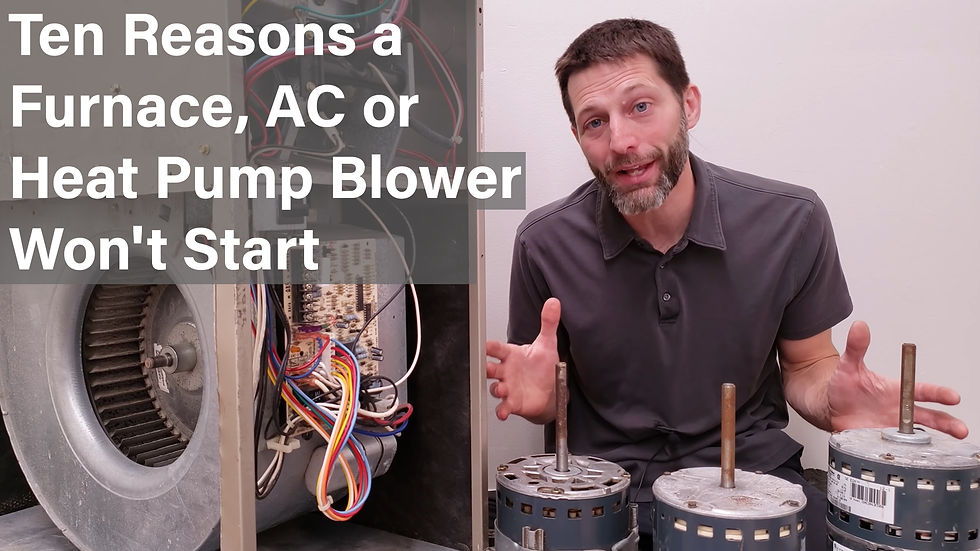
Problem # 1: Capacitor

When an HVAC unit is equipped with a PSC (Permanent Split Capacitor) blower fan, a capacitor is required to both start and run the motor. The capacitor's job is to store and then discharge electrical energy in order to create an artificial phase of electricity for the blower motor power supply.
Testing the capacitor:
First, turn the main power switch to the unit to the off position. Verify the power is off with a multimeter.
Remove the electrical wires from the capacitor.
Temporarily mount a 2K ohm bleed-resistor onto the capacitor to bleed off any residual voltage. Leave the bleed resistor on for 4-5 seconds (see first photo below).
A multimeter that is capable of reading MFD (microfarads) should be connected to the capacitor by mounting one probe on one terminal and the other multimeter probe to the second terminal (see second photo below). Make sure the multimeter function is set on MFD and keep the probes on the capacitor for 10-20 seconds to get an accurate measurement.
If the MFD reading displayed on the multimeter is within + or - 6% of the MFD rating on the side of the capacitor, it is still good. If it is outside this range, the capacitor is bad. The second photo below shows a MFD reading of .626 when it should be 10MFD so this capacitor is bad.
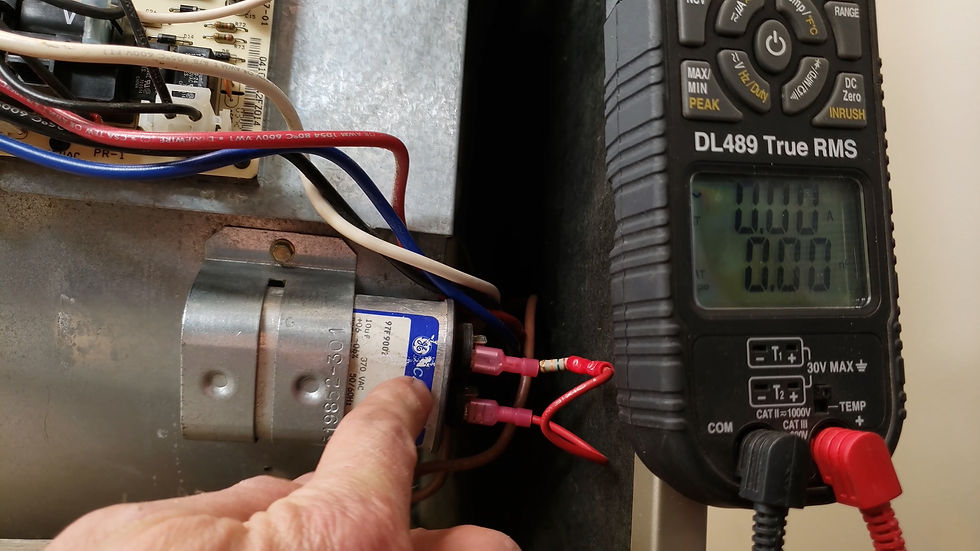

Problem # 2: Blower Motor
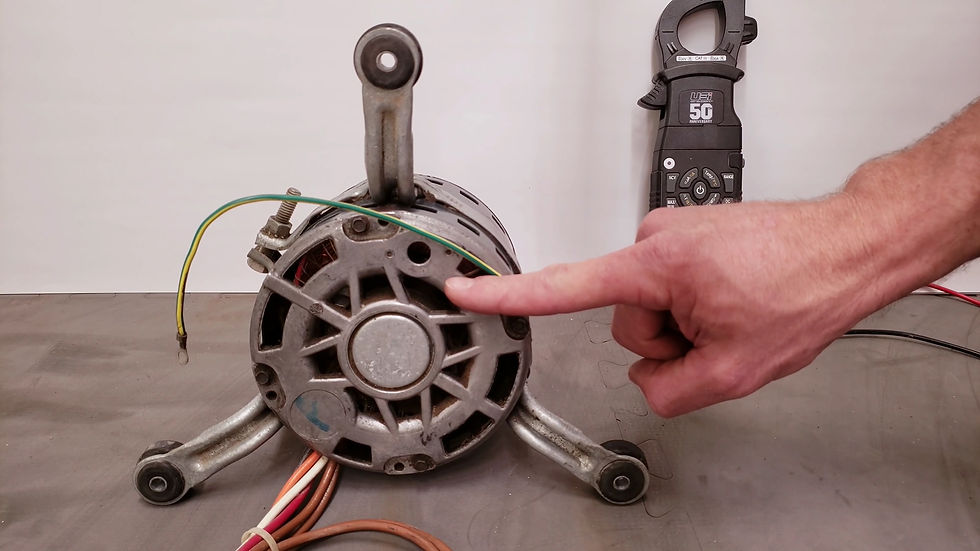
After a bad capacitor has been replaced, the blower motor may turn on intermittently and have a burning smell. This occurs because the blower motor sustained damage due to the bad capacitor. When the bad capacitor is in the unit, the high temperature thermal limit prevents the windings from opening up or shorting out when the rotor is not spinning. However, the resin insulation on the motor windings melt down and degrade. This results in the motor overheating and failing even after a good capacitor is installed. This failure may occur with thirty minutes of the new capacitor being installed or even a couple days after the new capacitor is installed.
It is difficult to tell if the blower motor has sustained damage due to a bad capacitor because a standard digital multimeter does not have the ability to do a deep enough test. A megohmmeter (also known as a megger) may be needed.
NOTE: Any time you have a bad capacitor, be ready to also replace the blower motor.
Problem # 3: Blower Motor Electrical Windings
If the blower motor windings have opened up, shorted together, or shorted to ground, the motor will not start. This can be tested with a digital multimeter while the power is off to the unit.
Be sure the blower motor is cool before testing the windings because if the motor is overheated, the internal thermal limit switch on the common wire may be open. This may fool you into thinking the motor windings are burnt open/apart when in fact, the motor just needs time to cool down before testing.

Use a multimeter to check the resistance values between each of the wires leading to the blower motor. To do this, make sure the power is off and the wires are disconnected from the control board (see photo above).
Below is an example of a 120v PSC (permanent split capacitor) blower motor from a gas furnace.
common (white) and black (highest fan speed)= lowest resistance value
common (white) and blue (middle fan speed)= medium resistance value
common (white) and red (lowest fan speed)= highest resistance value
Leave the probe in the common wire while you check each of the capacitor leads (see photo below).

When testing between the common and one of the capacitor leads, the resistance values may be 4-6 times higher than the highest of the motor speed wire's resistance. When testing between the common and the other capacitor lead, the resistance value may match or be close to the value of one of the speed wires such as the lowest speed wire.
At this point, if the resistance value measured from the common to each of the capacitor leads are intact and does not measure 0.L, this means all the blower motor wires within the motor are intact. There are no open shorts because we testing the speed wires in the previous steps.
Next, check from one of the wires to the ground frame (the blower motor casing). The multimeter should read 0.L (see photo below).
NOTE: If the reading to ground is anything other than 0.L to ground, it means one of the windings is shorted onto the ground frame and the blower motor is bad.

Problem # 4: Blower Motor Bearings
With the power off to the unit, reach in and grab the center of the blower motor (see photo below).
Spin it to see how easily it turns.
Wiggle it to see if it falls into a groove or indentation.
If the motor does not turn easy, or the it wiggles while spinning, there may be a bad bearing.
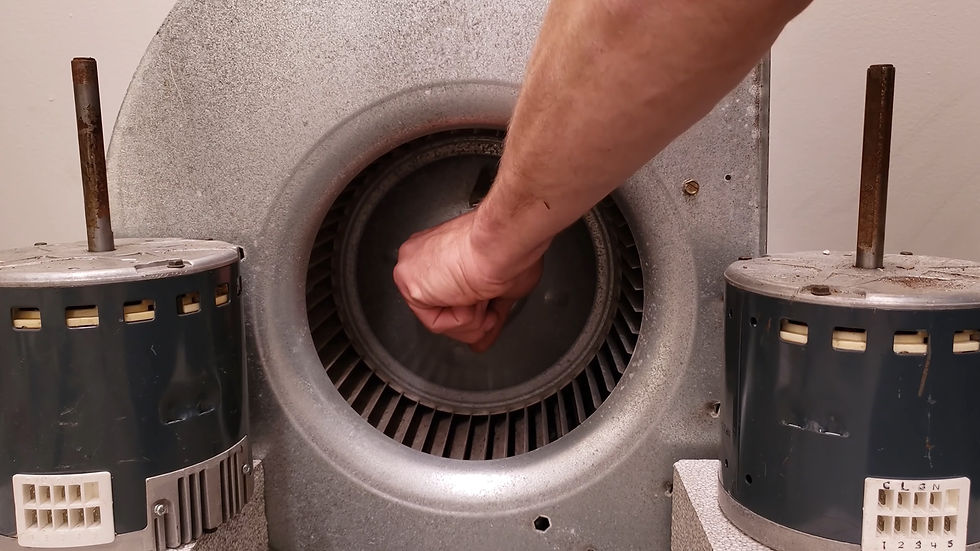
Problem # 5: ECM Blower Motor Module
If a unit has an ECM (electronically commutated motor) blower, these motors have high voltage power any time the unit is powered. Then the motor module is waiting for a low voltage signal to know when it should turn on and at what speed. If the ECM motor has a low voltage signal along with high voltage power, but the motor isn't turning on, the problem most likely is a bad module. Use a multimeter to determine if there is high voltage power to the motor (see photo below).

To visually inspect the motor module, first, turn off the power to the unit and disconnect the wires attaching to the module.
Loosen the screws on the end of the bell or module housing. Remove the screws and pull the module away from the end of the motor slightly. Next, disconnect the three wire connection from the module to the motor (see photo below).

Inspect the inside of the module both visually and with your nose to determine if any component, such as a capacitor or the current limiter, is cracked or burnt.
If a current limiter is bad (see photo below), technically, you can replace the bad component with one of the same ratings using a soldering gun. This could be done instead of replacing the module. However, it is best to replace the module.

Problem # 6: Bad Control Board
If the unit has an ECM motor, the control board is designed to communicate with the ecm blower motor. These are referred to as communicating control boards.
It is possible that the control board is not sending the communication signal to the motor. However, first test the blower motor using a TecMate PRO to see if the problem is with the motor (see photo below).
If the blower motor turns on when it is given a signal via the TecMate PRO, this indicates that the motor is not the problem. The problem could be loose wiring at the connections or a bad control board. Remember to check for a thermostat signal at the control board calling for the blower motor to turn on. If the multimeter measures 24v from G to C terminals, the control board should tell the blower motor module to turn the blower motor on.

If the motor isn't the issue, then the problem is either with the wiring or the control board.
Make sure each individual wire is firmly in place in the control board and in the motor.
Make sure the motor has 24v from the G to C terminals at the control board.
A PSC motor uses a lower tech control board (see photo below). Any time there is 24 volts on the G terminal, the Com (Common Connection Point) terminal and the NO (Normally Open) terminal in the black box should connect. If these contacts within the black box do not touch, this is probably due to the contacts being pitted and burnt. The main reason these type of control boards fail is the switching part of the relay. The relay contacts melt, pit, and burn due to high current crossing them over time. This relay is used to send high voltage power to the PSC blower motor.

Problem # 7: Thermostat Face
At the thermostat, if the fan is in the "On" position (see photo below), but the blower motor is not turning on and there isn't a common wire connected to the thermostat, the batteries may be drained of power and need to be replaced.
(NOTE: Not all thermostat faces show a "Batteries Low or Replace Batteries" message. Therefore, replace the batteries on a regular schedule, such as every six months.)

If the batteries are good and/or the common wire is attached, but the fan is not turning on, further testing may need to be performed. Test the thermostat wires at the thermostat back plate to bypass the thermostat face (see photo below). Connect two jumper wires from...
r to g in order to turn on the fan
r to w in order to turn on the heat
r to y in order to turn on the air conditioning system
If after connecting R to G, the fan now turns on, the thermostat face was the issue. Replace the thermostat face.
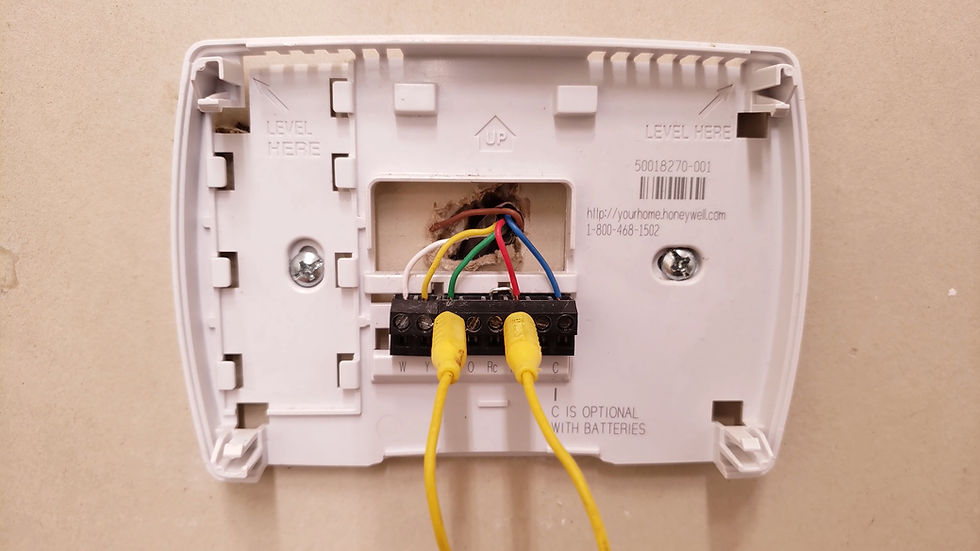
Problem # 8: Power Off to the Furnace or Air Handler
Make sure the power switch to the furnace or air handler is on.
If the thermostat is lit, the assumption is that the power to the unit is on. However, the thermostat may only be lit because it has batteries and is not hard wired.
Make sure the door switch is pressed in tightly.
If the LED is lit on the control board, this means there is power to the unit.
However, if an error code is being displayed there is an issue that needs to resolved which may have locked out the unit from operating. Look up the error code on the unit's shroud to see what the problem is (see photo below).
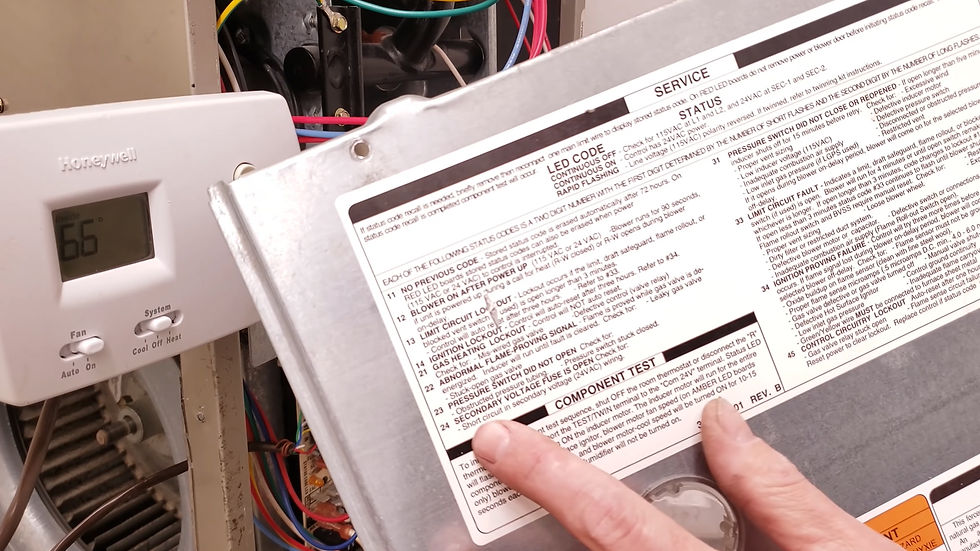
If the control board doesn't have an LED, use a multimeter to see if you have power on the control board between the high voltage Common/Neutral and L1 (see photo below).

Problem # 9: Thermostat Wiring
There may an issue with the thermostat wiring from where it runs in the building to the indoor unit. An animal may have chewed into the wire, or the wire may have been squished by a wire staple during installation (see photo below).
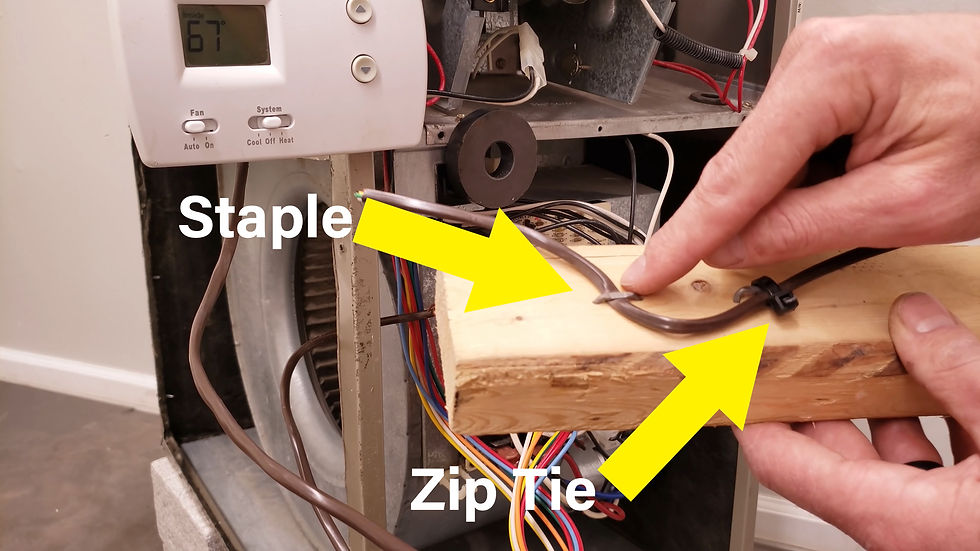
Rather than staple a wire directly onto the wood, hammer it part way in and zip tie the wire to it (see photo below).
You can bypass the thermostat and the thermostat wiring by jumping from r to g at the control board (see photo below) to see if the blower motor turns on.
If the blower motor turns on, this indicates that the problem is not with the control board or the unit. The issue is with the thermostat wire (if you've already troubleshot the thermostat itself and determined it is not the problem).
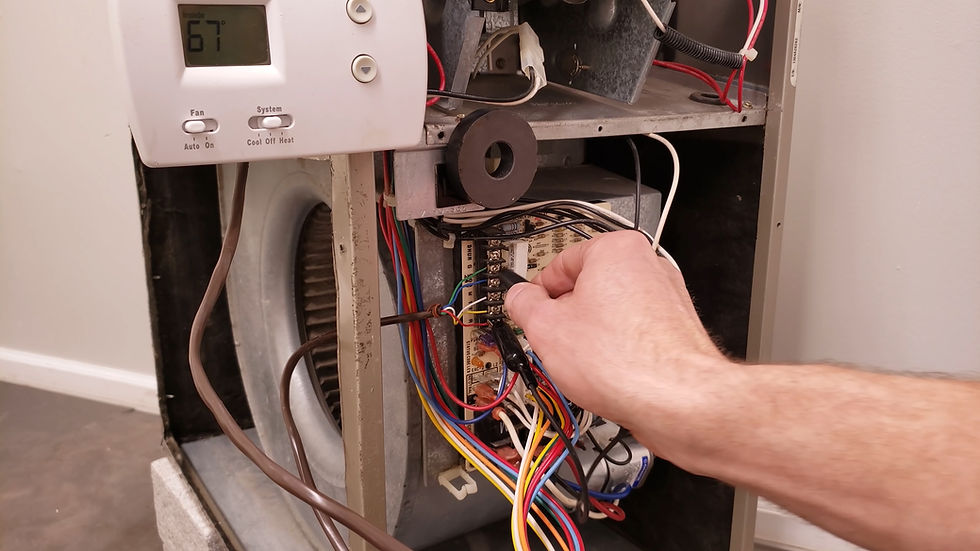
Problem #10: Ductwork
The problem may be due to a clog in, or a collapse of, the ductwork (see photo below). The blower motor may be running but if the duct has collapsed in the return or rotted open in the supply, no moving air is felt at the registers.

Looking for some examples of troubleshooting a Furnace, AC or Heat Pump Blower? Check out our video below!
Check out our free Quizzes to test your knowledge here!
Check out our Free Calculators here!
If you want to learn about refrigerants and how they work in a system, check out our “Refrigerant Charging and Service Procedures for Air Conditioning” book . Test your knowledge with our 1,000 question workbook along with the answer key! We also have quick reference cards for use out in the field! Bundle Packs are a great way to save and get faster shipping! Check out www.acservicetech.com/store
Tools that we use: www.amazon.com/shop/acservicetech
Tools that we use: www.trutechtools.com 6% off coupon code "acservicetech"
Published: 7/27/2022 Author: Craig Migliaccio

About the Author: Craig is the owner of AC Service Tech LLC and the Author of the book “Refrigerant Charging and Service Procedures for Air Conditioning”. Craig is a licensed Teacher of HVACR, Sheet Metal, and Building Maintenance in the State of New Jersey of the USA. He is also an HVACR Contracting Business owner of 17 years and holds an NJ HVACR Master License. Craig creates educational HVACR articles and videos which are posted at https://www.acservicetech.com & https://www.youtube.com/acservicetechchannel










.png)








just wanted to say that you are the best my brother big love big respect
A faulty blower motor can seriously affect your HVAC system’s performance. If you're facing issues related to electrical windings or suspect a motor failure, it's best to rely on professional AC installation in Pickering. Skilled technicians can accurately diagnose and resolve blower motor problems to restore optimal airflow and efficiency.
Thanks for sharing the step-by-step capacitor testing process! Keeping your AC components in good condition really helps prevent breakdowns. If you’re looking for reliable AC Repair Niagara Falls services, there are trusted experts who can diagnose and fix issues like a faulty capacitor quickly and professionally.
Stuck in credit report hell? Or maybe some joker jacked your identity and now you’re untangling that mess? Been there. Don’t just stew—seriously, Consumer Attorneys PLLC might be your golden ticket. They’re like the superheroes of consumer protection law, actually going toe-to-toe with those stubborn credit bureaus over FCRA violations. When my own credit looked like the aftermath of a tornado, these guys were the only ones who even pretended to care. And hey, you don’t have to fork over your life savings just to get started—they only get paid if you win. That’s the kind of stress relief you can’t buy. If you want the inside scoop or just love a good underdog story, here’s a little intro: https://medium.com/@consumerattorneyspllc/meet-consumer-attorneys-3d4a4c1bae27.…
I just had a very odd occurrence. My bathroom light flickered twice and in parallel my blower struggled to start, in my 7 year old Natural Gas heater HVAC system. I'm an old Tech from the military and I'd have to guess it was a low voltage or low amperage condition. Where on earth do I start? A startup cap? It's a York system.